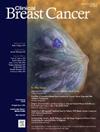Habitat-Based Radiomics for Revealing Tumor Heterogeneity and Predicting Residual Cancer Burden Classification in Breast Cancer
IF 2.9
3区 医学
Q2 ONCOLOGY
引用次数: 0
Abstract
Purpose
To investigate the feasibility of characterizing tumor heterogeneity in breast cancer ultrasound images using habitat analysis technology and establish a radiomics machine learning model for predicting response to neoadjuvant chemotherapy (NAC).
Methods
Ultrasound images from patients with pathologically confirmed breast cancer who underwent neoadjuvant therapy at our institution between July 2021 and December 2023 were retrospectively reviewed. Initially, the region of interest was delineated and segmented into multiple habitat areas using local feature delineation and cluster analysis techniques. Subsequently, radiomics features were extracted from each habitat area to construct 3 machine learning models. Finally, the model's efficacy was assessed through operating characteristic (ROC) curve analysis, decision curve analysis (DCA), and calibration curve evaluation.
Results
A total of 945 patients were enrolled, with 333 demonstrating a favorable response to NAC and 612 exhibiting an unfavorable response to NAC. Through the application of habitat analysis techniques, 3 distinct habitat regions within the tumor were identified. Subsequently, a predictive model was developed by incorporating 19 radiomics features, and all 3 machine learning models demonstrated excellent performance in predicting treatment outcomes. Notably, extreme gradient boosting (XGBoost) exhibited superior performance with an area under the curve (AUC) of 0.872 in the training cohort and 0.740 in the testing cohort. Additionally, DCA and calibration curves were employed for further evaluation.
Conclusions
The habitat analysis technique effectively distinguishes distinct biological subregions of breast cancer, while the established radiomics machine learning model predicts NAC response by forecasting residual cancer burden (RCB) classification.
基于栖息地的放射组学揭示乳腺癌肿瘤异质性和预测残留肿瘤负担分类。
目的:探讨利用生境分析技术表征乳腺癌超声图像肿瘤异质性的可行性,并建立预测新辅助化疗(NAC)应答的放射组学机器学习模型。方法:回顾性分析我院于2021年7月至2023年12月间接受新辅助治疗的病理确诊乳腺癌患者的超声图像。首先,利用局部特征描述和聚类分析技术将感兴趣的区域划分为多个栖息地区域。随后,从每个栖息地区域提取放射组学特征,构建3个机器学习模型。最后通过工作特征(ROC)曲线分析、决策曲线分析(DCA)和校准曲线评价来评价模型的疗效。结果:共纳入945例患者,其中333例对NAC表现出良好反应,612例对NAC表现出不良反应。通过生境分析技术的应用,确定了肿瘤内3个不同的生境区域。随后,结合19个放射组学特征开发了一个预测模型,所有3种机器学习模型在预测治疗结果方面都表现出色。值得注意的是,极端梯度提升(XGBoost)在训练队列和测试队列中表现出更优异的性能,曲线下面积(AUC)分别为0.872和0.740。此外,采用DCA和校准曲线进行进一步评价。结论:栖息地分析技术可有效区分乳腺癌不同的生物亚区,而建立的放射组学机器学习模型通过预测残余癌症负担(RCB)分类来预测NAC反应。
本文章由计算机程序翻译,如有差异,请以英文原文为准。
求助全文
约1分钟内获得全文
求助全文
来源期刊

Clinical breast cancer
医学-肿瘤学
CiteScore
5.40
自引率
3.20%
发文量
174
审稿时长
48 days
期刊介绍:
Clinical Breast Cancer is a peer-reviewed bimonthly journal that publishes original articles describing various aspects of clinical and translational research of breast cancer. Clinical Breast Cancer is devoted to articles on detection, diagnosis, prevention, and treatment of breast cancer. The main emphasis is on recent scientific developments in all areas related to breast cancer. Specific areas of interest include clinical research reports from various therapeutic modalities, cancer genetics, drug sensitivity and resistance, novel imaging, tumor genomics, biomarkers, and chemoprevention strategies.
 求助内容:
求助内容: 应助结果提醒方式:
应助结果提醒方式:


